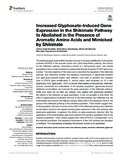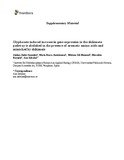Mostrar el registro sencillo del ítem
Increased glyphosate-induced gene expression in the shikimate pathway is abolished in the presence of aromatic amino acids and mimicked by shikimate
| dc.creator | Zulet González, Ainhoa | es_ES |
| dc.creator | Barco Antoñanzas, María | es_ES |
| dc.creator | Gil Monreal, Miriam | es_ES |
| dc.creator | Royuela Hernando, Mercedes | es_ES |
| dc.creator | Zabalza Aznárez, Ana | es_ES |
| dc.date.accessioned | 2020-07-03T12:54:13Z | |
| dc.date.available | 2020-07-03T12:54:13Z | |
| dc.date.issued | 2020 | |
| dc.identifier.issn | 1664-462X | |
| dc.identifier.uri | https://hdl.handle.net/2454/37303 | |
| dc.description.abstract | The herbicide glyphosate inhibits the plant enzyme 5-enolpyruvylshikimate-3-phosphate synthase (EPSPS) in the aromatic amino acid (AAA) biosynthetic pathway, also known as the shikimate pathway. Amaranthus palmeri is a fast-growing weed, and several populations have evolved resistance to glyphosate through increased EPSPS gene copy number. The main objective of this study was to elucidate the regulation of the shikimate pathway and determine whether the regulatory mechanisms of glyphosate-sensitive and glyphosate-resistant plants were different. Leaf disks of sensitive and resistant (due to EPSPS gene amplification) A. palmeri plants were incubated for 24 h with glyphosate, AAA, glyphosate + AAA, or several intermediates of the pathway: shikimate, quinate, chorismate and anthranilate. In the sensitive population, glyphosate induced shikimate accumulation and induced the gene expression of the shikimate pathway. While AAA alone did not elicit any change, AAA applied with glyphosate abolished the effects of the herbicide on gene expression. It was not possible to fully mimic the effect of glyphosate by incubation with any of the intermediates, but shikimate was the intermediate that induced the highest increase (three-fold) in the expression level of the genes of the shikimate pathway of the sensitive population. These results suggest that, in this population, the lack of end products (AAA) of the shikimate pathway and shikimate accumulation would be the signals inducing gene expression in the AAA pathway after glyphosate application. In general, the effects on gene expression detected after the application of the intermediates were more severe in the sensitive population than in the resistant population. These results suggest that when EPSPS is overexpressed, as in the resistant population, the regulatory mechanisms of the AAA pathway are disrupted or buffered. The mechanisms underlying this behavior remain to be elucidated. | en |
| dc.description.sponsorship | This work was supported by two grants from the Ministerio Español de Economía y Competitividad (Project number AGL2016-77531-R). AZ-G and MB-A received funding from fellowships through Universidad Pública de Navarra. | en |
| dc.format.extent | 11 p. | |
| dc.format.mimetype | application/pdf | en |
| dc.language.iso | eng | en |
| dc.publisher | Frontiers Media | en |
| dc.relation.ispartof | Frontiers in Plant Science, 2020, 11, 459 | en |
| dc.rights | © 2020 Zulet-González, Barco-Antoñanzas, Gil-Monreal, Royuela and Zabalza. This is an open-access article distributed under the terms of the Creative Commons Attribution License (CC BY). The use, distribution or reproduction in other forums is permitted, provided the original author(s) and the copyright owner(s) are credited and that the original publication in this journal is cited, in accordance with accepted academic practice. No use, distribution or reproduction is permitted which does not comply with these terms. | en |
| dc.subject | Amaranthus palmeri | en |
| dc.subject | Aromatic amino acids | en |
| dc.subject | Shikimate | en |
| dc.subject | Quinate | en |
| dc.subject | Chorismate | en |
| dc.subject | Anthranilate | en |
| dc.subject | Glyphosate | en |
| dc.title | Increased glyphosate-induced gene expression in the shikimate pathway is abolished in the presence of aromatic amino acids and mimicked by shikimate | en |
| dc.type | info:eu-repo/semantics/article | en |
| dc.type | Artículo / Artikulua | es |
| dc.contributor.department | Institute for Multidisciplinary Research in Applied Biology - IMAB | es_ES |
| dc.rights.accessRights | info:eu-repo/semantics/openAccess | en |
| dc.rights.accessRights | Acceso abierto / Sarbide irekia | es |
| dc.identifier.doi | 10.3389/fpls.2020.00459 | |
| dc.relation.projectID | info:eu-repo/grantAgreement/ES/1PE/AGL2016-77531-R | en |
| dc.relation.publisherversion | https://doi.org/10.3389/fpls.2020.00459 | |
| dc.type.version | info:eu-repo/semantics/publishedVersion | en |
| dc.type.version | Versión publicada / Argitaratu den bertsioa | es |
| dc.contributor.funder | Universidad Pública de Navarra / Nafarroako Unibertsitate Publikoa | es |



